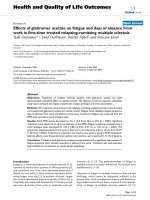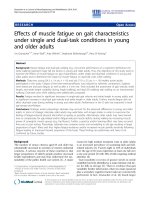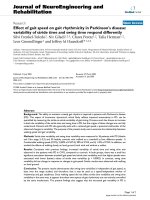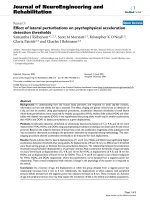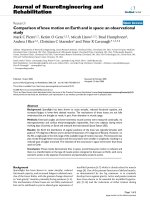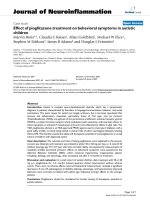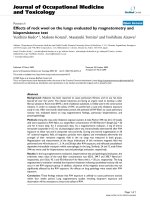báo cáo hóa học: " Boundedness of positive operators on weighted amalgams" doc
Bạn đang xem bản rút gọn của tài liệu. Xem và tải ngay bản đầy đủ của tài liệu tại đây (302.55 KB, 12 trang )
RESEARC H Open Access
Boundedness of positive operators on weighted
amalgams
María Isabel Aguilar Cañestro and Pedro Ortega Salvador
*
* Correspondence: portega@uma.
es
Análisis Matemático, Facultad de
Ciencias, Universidad de Málaga,
29071 Málaga, Spain
Abstract
In this article, we characterize the pa irs (u, v) of positive measurable functions such
that T maps the weighted amalgam
(
L
¯
p
(
v
)
,
¯
q
)
in (L
p
(u), ℓ
q
) for all
1 <
p
,
q
,
¯
p
,
¯
q
<
∞
,
where T belongs to a class of positive operators which includes Hardy operators,
maximal operators, and fractional integrals.
2000 Mathematics Subject Classification 26D10, 26D15 (42B35)
Keywords: Amalgams, Maximal operators, Weighted inequalities, Weights
1. Introduction
Let u be a positive funct ion of one real variable and let p, q > 1. The amalgam (L
p
(u),
ℓ
q
) is the space of one variable real functions which are loc ally in L
p
(u) and globally in
ℓ
q
. More precisely,
(L
p
(u),
q
)={f : ||f ||
p
,u,
q
< ∞}
,
where
||f ||
p,u,q
=
⎧
⎪
⎪
⎪
⎨
⎪
⎪
⎪
⎩
n∈Z
⎛
⎝
n+1
n
|f |
p
u
⎞
⎠
q
p
⎫
⎪
⎪
⎪
⎬
⎪
⎪
⎪
⎭
1
q
.
These spaces were introduced by Wiener in [1]. The article [2] describes the role
played by amalgams in Harmonic Analysis.
Carton-Lebrun, Heinig, a nd Hoffmann studied in [3] the boundedness of the Hardy
operator
Pf (x)=
x
−
∞
|f
|
in weighted amalgam spaces. They characterized the pairs of
weights (u, v) such that the inequality
||Pf ||
p,u,q
≤ C||f ||
¯
p
,v,
¯
q
(1:1)
holds for al l f, with a constant C independent of f,whenever
1 <
¯
q
≤
q
<
∞
.The
characterization of the pairs (u, v) for (1.1) to hold in the case
1 <
q
<
¯
q
< ∞
has
been recently completed by Ortega and Ramírez ([4]), who have al so characterized the
weak type inequality
Pf
p
,∞;u,
q
≤ C
f
¯
p
,v,
¯
q
,
Aguilar Cañestro and Ortega Salvador Journal of Inequalities and Applications 2011, 2011:13
/>© 2011 Cañestro and Salvador; licensee Springer. This is an Open Access article distributed under the terms of the Creative Commons
Attribution License (http://crea tivecommons.org/licens es/by/2.0), which permits unrestricted use, distribution, and re prod uction in
any medium, provide d the origin al work is properly cited.
where
|
|g||
p,∞;u,q
=
n∈Z
||gX
(n,n+1)
||
q
p,∞,u
1
q
.
There are s everal articles dealing wit h the boundedness in weighted amalgams of
other operators different from Hardy’s one. Specifically, Carton-Lebrun, Heinig, and
Hoffmann studied in [3] weighted inequalities in amalgams for the H ardy-Littlewood
maxi mal operator as well as for some integral operators with kernel K(x, y) i ncreasing
in the second variable and decreasing in the first one. On the other hand, Rakotondrat-
simba ([5]) characterized some weighted inequalities in amalgams (corresponding to
the cases
1 <
¯
p
≤
p
<
∞
and
1 <
¯
q
≤
q
<
∞
) for the fractional maximal operators and
the fractional i ntegrals. Finally, the authors characterized in [6] the weighted inequal-
ities for some generalized Hardy operators, including the fractional integrals of order
greater than one, in all cases
1 <
p
,
¯
p
,
q
,
¯
q
<
∞
, extending also results due to Heinig
and Kufner [7].
Analyzing the results in the articles cited above, one can see some common features
that lead to explo re the possibility of giving a general theorem characterizing the
boundedness in weighted amalgams of a wide family of positive operators , and provid-
ing, in such a way, a unified approach to the subject. This is the purpose of this article.
2. The results
We consider an operator T acting on real measurable functions f of one real variable
and define a sequence {T
n
}
nÎℤ
of local operators by
T
n
f (x)=T(f X
(
n−1,n+2
)
)(x) x ∈ (n − 1, n +2)
.
We assume that there exists a discrete operat or T
d
, i.e., which transforms sequences
of real numbers in sequences of real numbers, verifying the following conditions:
(i) There exists C > 0 such that for all non-negative functions f,alln Î ℤ and all x
Î (n, n + 1), the inequality
T
f X
(−∞,n−1)
+ f X
(n+2,∞)
(x) ≤ CT
d
⎛
⎝
⎧
⎨
⎩
m
m−1
f
⎫
⎬
⎭
⎞
⎠
(n
)
(2:1)
holds.
(ii) There exists C > 0 such that for all sequences {a
k
} of non-negative real numbers
and n Î ℤ, the inequality
T
d
(
{a
k
}
)(
n
)
≤ CTf
(
y
),
(2:2)
holds for all y Î (n, n + 1) and all non-negative f such that
m
m
−1
f = a
m
for all m.
We also assume that T verifies Tf = T |f|, T(lf)=|l|Tf, T(f + g)(x) ≤ Tf (x)+Tg (x)
and Tf(x) ≤ Tg(x)if0≤ f (x) ≤ g(x).
Aguilar Cañestro and Ortega Salvador Journal of Inequalities and Applications 2011, 2011:13
/>Page 2 of 12
We will say that an operator T verifying all the above conditions is admissible.
There is a number of important admissible operators in Analysis. For instance:
Hardy operators, Hardy-Littlewood maximal operators, Riemann-Liouvill e, and Weyl
fractional integral operators, maximal fractional operators, etc.
Our main result is the following one:
Theorem 1. Let
1 <
p
,
q
,
¯
p
,
¯
q
<
∞
. Let u and v be positive locally integrable functions
on ℝ and let T be an admissible operator. Then there exists a constant C >0such that
the inequality
|
|Tf ||
p,u,q
≤ C||f ||
¯
p
,v,
¯
q
.
(2:3)
holds for all measurable functions f if and only if the following conditions hold:
(i) T
d
is bounded from
¯
q
(
{v
n
}
)
to ℓ
q
({u
n
}), where
v
n
=
n
n−1
v
1−
¯
p
−
¯
q
¯
p
and
u
n
=
n+1
n
u
q
p
.
(ii) (a)
sup
n
∈
Z
||
T
n
||
(L
¯
p
(v),L
p
(u))
<
∞
in the case
1 <
¯
q
≤
q
<
∞
.
(b)
{||T
n
||
(
L
¯
p
(
v
)
,L
p
(
u
))
}∈
s
, with
1
s
=
1
q
−
1
¯
q
, in the case
1 <
q
<
¯
q
<
∞
.
The proof of Theorem 1 is contained in Sect. 3.
Working as in Theorem 1, we can also prove the following weak type result:
Theorem 2. Let
1 <
p
,
q
,
¯
p
,
¯
q
<
∞
. Let u and v be positive locally integrable functions
on ℝ and let T be an admissible operator. Then there exists a constant C >0such that
the inequality
|
|Tf ||
p,∞,u,q
≤ C||f ||
¯
p
,v,
¯
q
(2:4)
holds for all measurable functions f if and only if the following conditions hold:
(i) T
d
is bounded from
¯
q
(
{v
n
}
)
to ℓ
q
({u
n
}),), with v
n
and un defined as in Theorem 1.
(ii) (a)
sup
n
∈
Z
||
T
n
||
(L
¯
p
(v),L
p,∞
(u))
<
∞
in the case
1 <
¯
q
≤
q
<
∞
.
(b)
{||T
n
||
(
L
¯
p
(
v
)
,L
p,∞
(
u
))
}∈
s
, with
1
s
=
1
q
−
1
¯
q
, in the case
1 <
q
<
¯
q
< ∞
.
If conditions on the weights u, v, and {u
n
}, {v
n
} characterizing the boundedness of the
operators T
n
and T
d
, respectively, are available in the literature, we immediately obtain,
by applying Theorems 1 and 2, conditions guaranteeing the boundedness of T between
the weighted amalgams. In this sense, our result includes, as particular cases, most of
the results cited above from the papers [3-7], as well as other corresponding to opera-
tors whose behavior on weighted amalgams has not been studied yet.
Thus, if M
-
is the one-sided Hardy-Littlewood maximal operator defined by
M
−
f (x)=sup
h>0
1
h
x
x
−
h
|f |
,
Aguilar Cañestro and Ortega Salvador Journal of Inequalities and Applications 2011, 2011:13
/>Page 3 of 12
we have:
(i) The discrete operator ( M
-
)
d
, defined by
(M
−
)
d
({a
n
})(j)= sup
k≤j−1
1
j − k
j−1
i
=
k
| a
i
|
,
verifies conditions (2.1) and (2.2).
(ii) The local operators
M
−
n
are defined by
M
−
n
f (x)= sup
0<h
≤
x−n+1
1
h
x
x
−
h
|f |, x ∈ (n − 1, n +2)
.
(iii) If
p
=
¯
p
and
q
=
¯
q
, there are well-known conditions on the weights u, v, and {u
n
},
{v
n
} that characterize the boundedness of
M
−
n
and (M
-
)
d
(see, for instance [8-10]).
Therefore, we obtain the following result:
Theorem 3. The following statements are equivalent:
(i) M
-
is bounded from (L
p
(w), ℓ
q
) to (L
p
(w), ℓ
q
).
(ii) M
-
is bounded from (L
p
(w), ℓ
q
) to (L
p,∞
(w), ℓ
q
).
(iii) The next conditions hold simultaneously:
(a)
w ∈
A
−
p,
(
n−1,n+2
)
for all n, uniformly, and
(b) the pair ({u
n
}, {v
n
}) verifies the discrete Sawyer’s condition
S
−
q
, i.e., there exists
C >0such that
k
j
=r
((M
−
)
d
({v
1−q
n
}))
q
(j)u
j
≤ C
k
j
=r
v
1−q
j
,
for all r, k Î ℤ with r ≤ k.
We can state a similar result for the one-sided maximal operator M
+
. In this case,
the operator (M
+
)
d
defined by
(M
+
)
d
({a
n
})(j)= sup
k≥
j
+3
1
k − j − 2
k
i=
j
+3
| a
i
|
,
verifies conditions (2.1) and (2.2). The theorem is the next one:
Theorem 4. The following statements are equivalent:
(i) M
+
is bounded from (L
p
(w), ℓ
q
) to (L
p
(w), ℓ
q
).
(ii) M
+
is bounded from (L
p
(w), ℓ
q
) to (L
p,∞
(w), ℓ
q
).
(iii) The next conditions hold simultaneously:
(a)
w ∈ A
+
p,
(
n−1,n+2
)
for all n, uniformly, and
(b) the pair ({u
n
}, {v
n-3
}) verifies the discrete Sawyer’ s condition
S
+
q
, i.e., there
exists C >0such that
k
j
=r
((M
+
)
d
({v
1−q
n
}))
q
(j)u
j
≤ C
k
j
=r
v
1−q
j
,
Aguilar Cañestro and Ortega Salvador Journal of Inequalities and Applications 2011, 2011:13
/>Page 4 of 12
for all r, k Î ℤ with r ≤ k.
If M is the Hardy-Littlewood maximal operator, defined by
Mf (x)=sup
x∈I
1
|I|
I
|f |
,
then M is admissible, with
M
d
({a
n
})(j)= sup
r≤
j
≤k
1
k − r +1
k
i=r
| a
i
|
,andtherearewell-
known results, due to Muckenhoupt ([11]) and Sawyer ([12]), which characterize the
boundedness of M in weighted Lebesgue spaces. Applying Theorems 1 and 2, we get
the following result:
Theorem 5. The following statements are equivalent:
(i) M is bounded from (L
p
(w), ℓ
q
) to (L
p
(w), ℓ
q
).
(ii) M is bounded from (L
p
(w), ℓ
q
) to (L
p,∞
(w), ℓ
q
).
(iii) The next conditions hold simultaneously:
(a) w Î A
p,(n-1,n+2)
for all n, uniformly, and
(b) the pair ({u
n
}, {v
n
}) verifies t he discrete two-sided Sawyer’sconditionS
q
, i.e.,
there exists C >0such that
k
j
=r
(M
d
({v
1−q
n
})
q
(j)u
j
≤ C
k
j
=r
v
1−q
j
for all r, k Î ℤ with r ≤ k.
This result improves the one obtained by Carton-Lebrun, Heinig an d Hofmann in
[3], in the sense that the conditions we give are necessary and sufficient for the bound-
edness of the maximal operator in the amalgam (L
p
(w), ℓ
q
), while in [3] only sufficient
conditons were given. We also prove the equivalence between the strong type inequal-
ityandtheweaktypeinequality.Theequivalence(i)⇔ (iii) in Theorem 5 is included
in Rakotondratsimba’s paper [5], where the proof of the admissibility of M can also be
found.
Finally, we will apply our results to the fractional maximal operator M
a
,0<a <1,
defined by
M
α
f (x)= sup
c<x<d
1
(
d − c
)
1−α
d
c
| f |
.
The proof of the admissibility of M
a
, with the obvious
M
d
α
, is implied in Rakoton-
dratsimba’s paper ([5]).
Verb itsky ([13]) in the case 1 <q < p < ∞ and Sawyer ([12]) in the case 1 <p ≤ q < ∞
characterized the bo undednes s of M
a
from L
p
to L
q
(w). These results allow us to give
necessary and sufficient conditions on the weight u for M
a
to be bounded from
(
L
¯
p
,
¯
q
)
to
(
L
p
(
u
)
,
q
)
.
Aguilar Cañestro and Ortega Salvador Journal of Inequalities and Applications 2011, 2011:13
/>Page 5 of 12
Before stating the theorem, we introduce the notation:
(i) If
1 <
¯
q
< ∞
, we define H : ℤ ® ℝ by
H(i)= sup
r≤i≤k
1
(
k − r +1
)
1−α
¯
q
k
j=r
u
j
.
(ii) If
1 <
¯
q
≤
q
, we define
J
=sup
r≤k
||X
[r,k]
M
d
α
(X
[r,k]
)||
q
({u
j
})
(
k − r +1
)
1
¯
q
.
(iii) If
1 <
¯
p
< ∞
and n Î ℤ, we define for x Î (n-1, n +2)
H
n
(x)= sup
x∈I⊂
(
n−1,n+2
)
1
|I|
1−α
¯
p
I
u
.
(iv) If
1 <
¯
p
<
p
and n Î ℤ, we define
J
n
=sup
I⊂(n−1,n+2)
||X
I
M
α
(X
I
)||
L
p
(u)
|
I
|
1
¯
p
.
The result reads as follows.
Theorem 6. M
a
is bounded from
(
L
¯
p
,
¯
q
)
to (L
p
(u), ℓ
q
) if and only if
(i) in the case
1 <
¯
p
≤
p
<
∞
and
1 <
¯
q
≤
q
<
∞
, sup
nÎℤ
J
n
< ∞ and J < ∞;
(ii) in the case
1 <
p
<
¯
p
<
∞
and
1 <
¯
q
≤
q
<
∞
,
sup
n∈Z
||
H
n
||
L
p
¯
p
−p
(
u
)
<
∞
and J < ∞;
(iii) in the case
1 <
¯
p
≤
p
<
∞
and
1 <
q
<
¯
q
<
∞
,{J
n
}
n
Î ℓ
s
, where
1
s
=
1
q
−
1
¯
q
,
and
H ∈
q
¯
q−q
({u
j
}
)
;
(iv) in the case
1 <
p
<
¯
p
<
∞
and
1 <
q
<
¯
q
< ∞
,
|
|H
n
||
L
p
¯
p
−p
(
u
)
∈
s
and
H ∈
q
¯
q−q
({u
j
}
)
.
3. Proof of Theorem 1
Let us suppose that the inequality ( 2.3) holds. Let n Î ℤ and let f be a non-negative
function supported in (n-1, n + 2). Then, on one hand,
|
|f ||
¯
p,v,
¯
q
=
⎧
⎪
⎪
⎪
⎪
⎨
⎪
⎪
⎪
⎪
⎩
⎛
⎝
n
n−1
f
¯
p
v
⎞
⎠
¯
q
¯
p
+
⎛
⎝
n+1
n
f
¯
p
v
⎞
⎠
¯
q
¯
p
+
⎛
⎝
n+2
n+1
f
¯
p
v
⎞
⎠
¯
q
¯
p
⎫
⎪
⎪
⎪
⎪
⎬
⎪
⎪
⎪
⎪
⎭
1
¯
q
≤ C
¯
p,
¯
q
⎛
⎝
n+2
n−1
f
¯
p
v
⎞
⎠
1
¯
p
,
Aguilar Cañestro and Ortega Salvador Journal of Inequalities and Applications 2011, 2011:13
/>Page 6 of 12
and, on the other hand,
|
|Tf ||
p,u,q
≥
⎧
⎪
⎪
⎪
⎨
⎪
⎪
⎪
⎩
⎛
⎝
n
n−1
(Tf )
p
u
⎞
⎠
q
p
+
⎛
⎝
n+1
n
(Tf )
p
u
⎞
⎠
q
p
+
⎛
⎝
n+2
n+1
(Tf )
p
u
⎞
⎠
q
p
⎫
⎪
⎪
⎪
⎬
⎪
⎪
⎪
⎭
1
q
≥ C
p,q
⎛
⎝
n+2
n−1
(Tf )
p
u
⎞
⎠
1
p
≥ C
p,q
⎛
⎝
n+2
n−1
(T
n
f )
p
u
⎞
⎠
1
p
= C
p
,
q
||T
n
f ||
p
,u
.
Therefore, by (2.3), T
n
is bounded and
||T
n
||
(
L
¯
p
(
v
)
,L
p
(
u
))
≤
C
, where C is a positive con-
stant in dependent of n. Then (ii)a holds independently of the relationship between q
and
¯
q
. Let us prove that if
1 <
q
<
¯
q
< ∞
, then (ii)b also holds.
It is well known that
||T
n
||
(L
¯
p
(v),L
p
(u))
=sup
{f :||f ||
L
¯
p
(
v
)
=1}
||T
n
f ||
L
p
(u
)
.Therefore,foreachn
there exists a non-negative measurable function f
n
, with support in (n-1, n +2)and
with
||f
n
||
(
L
¯
p
(
v
)
,
(
n−1,n+2
))
=
1
, such that
||T
n
||
(L
¯
p
(v),L
p
(u))
< ||T
n
f
n
||
L
p
(u)
+
1
2
|n|
.
Since
1
2
|n|
∈
s
,toprovethat
{||T
n
||
(
L
¯
p
(
v
)
,L
p
(
u
))
}∈
s
it suffices to see that
{||T
n
f
n
||
L
p
(
u
)
}∈
s
.
Let {a
n
} be a sequence of non-negative real numbers and
f =
n
a
n
f
n
. For each n Î ℤ,
f(x) ≥ a
n
f
n
(x) and then Tf (x) ≥ a
n
T
n
f
n
(x) for all x Î (n-1, n + 2). Thus,
|
|Tf ||
p,u,q
≥ C
⎧
⎪
⎪
⎨
⎪
⎪
⎩
n∈Z
n+2
n−1
a
p
n
(T
n
f
n
)
p
u
q
p
⎫
⎪
⎪
⎬
⎪
⎪
⎭
1
q
= C
n∈Z
a
q
n
||T
n
f
n
||
q
L
p
(u)
1
q
.
Then, from (2.3) we deduce
n∈Z
a
q
n
||T
n
f
n
||
q
L
p
(u)
1
q
≤ C
⎧
⎪
⎪
⎪
⎪
⎨
⎪
⎪
⎪
⎪
⎩
n∈Z
⎛
⎝
n+2
n−1
f
¯
p
v
⎞
⎠
¯
q
¯
p
⎫
⎪
⎪
⎪
⎪
⎬
⎪
⎪
⎪
⎪
⎭
1
¯
q
≤ C
⎧
⎪
⎪
⎪
⎪
⎨
⎪
⎪
⎪
⎪
⎩
n∈Z
a
¯
q
n
⎛
⎝
n+2
n−1
f
¯
p
n
v
⎞
⎠
¯
q
¯
p
⎫
⎪
⎪
⎪
⎪
⎬
⎪
⎪
⎪
⎪
⎭
1
¯
q
= C
n∈Z
a
¯
q
n
.
Aguilar Cañestro and Ortega Salvador Journal of Inequalities and Applications 2011, 2011:13
/>Page 7 of 12
This means that the identity operator is bounded from
¯
q
to
q
||T
n
f
n
||
q
L
p
(u)
. Then
{||T
n
f
n
||
L
p
(
u
)
}∈
s
, by applying the following lemma (see [4]).
Lemma 1. Let
1 <
q
<
¯
q
< ∞
and
1
s
=
1
q
−
1
¯
q
. Suppose that {u
n
} and {v
n
} are
sequences of positive real numbers. The following statements are equivalent:
(i) There exists C >0 such that the inequality
n∈Z
(|a
n
|u
n
)
q
1
q
≤ C
n∈Z
(|a
n
|v
n
)
¯
q
1
¯
q
holds for all sequences {a
n
} of real numbers.
(ii) The sequence
{u
n
v
−1
n
}
belongs to the space l
s
.
On the other hand, let us prove that (i) holds. If {a
m
} is a a sequence of non-negative
real numbers and
f =
m∈Z
a
m
χ
(m−1,m)
⎛
⎝
m
m−1
ν
1−
¯
p
⎞
⎠
−
1
ν
1−
¯
p
,
then
m
m−1
f = a
m
,
m
m−1
f
¯
p
v = a
¯
p
m
m
m−1
v
1−
¯
p
1−
¯
p
and by the properties of the operator
T we have
||Tf ||
p,u,q
=
⎧
⎪
⎪
⎪
⎨
⎪
⎪
⎪
⎩
n∈Z
⎛
⎝
n+1
n
(Tf)
p
(x)u(x)dx
⎞
⎠
q
p
⎫
⎪
⎪
⎪
⎬
⎪
⎪
⎪
⎭
1
q
≥ C
⎧
⎪
⎪
⎪
⎨
⎪
⎪
⎪
⎩
n∈Z
⎛
⎝
n+1
n
T
d
⎛
⎝
⎧
⎨
⎩
m
m−1
f
⎫
⎬
⎭
⎞
⎠
p
(n)u(x)dx
⎞
⎠
q
p
⎫
⎪
⎪
⎪
⎬
⎪
⎪
⎪
⎭
1
q
= C
⎧
⎪
⎪
⎪
⎨
⎪
⎪
⎪
⎩
n∈Z
T
d
({a
m
})
q
(n)
⎛
⎝
n+1
n
u(x)dx
⎞
⎠
q
p
⎫
⎪
⎪
⎪
⎬
⎪
⎪
⎪
⎭
1
q
= ||T
d
{a
m
}||
q
{u
n
}
)
.
Aguilar Cañestro and Ortega Salvador Journal of Inequalities and Applications 2011, 2011:13
/>Page 8 of 12
Applying (2.3) we obtain
||T
d
{a
m
}||
q
({u
n
})
≤ C
⎧
⎪
⎪
⎪
⎪
⎨
⎪
⎪
⎪
⎪
⎩
n∈Z
⎛
⎝
n+1
n
f
¯
p
v
⎞
⎠
¯
q
¯
p
⎫
⎪
⎪
⎪
⎪
⎬
⎪
⎪
⎪
⎪
⎭
1
¯
q
= C
⎧
⎪
⎪
⎪
⎪
⎨
⎪
⎪
⎪
⎪
⎩
n∈Z
a
¯
q
n
⎛
⎝
n
n−1
v
1−
¯
p
⎞
⎠
−
¯
q
¯
p
⎫
⎪
⎪
⎪
⎪
⎬
⎪
⎪
⎪
⎪
⎭
1
¯
q
= ||a
n
||
¯
q
(
{v
n
}
)
,
which means that the discrete operator T
d
is bounded from
¯
q
(
{v
n
}
)
to ℓ
q
({u
n
}), as
we wished to prove.
Conversely, let us suppose that (i) and (ii) hold. Then, we have
||Tf ||
p,u,q
≤ C
⎧
⎪
⎪
⎪
⎨
⎪
⎪
⎪
⎩
n∈Z
⎛
⎝
n+1
n
(T(f χ
(−∞,n−1)
+ f χ
(n+2,∞)
))
p
u
⎞
⎠
q
p
⎫
⎪
⎪
⎪
⎬
⎪
⎪
⎪
⎭
1
q
+ C
⎧
⎪
⎪
⎪
⎨
⎪
⎪
⎪
⎩
n∈Z
⎛
⎝
n+1
n
(Tf χ
(n−1,n+2)
)
p
u
⎞
⎠
q
p
⎫
⎪
⎪
⎪
⎬
⎪
⎪
⎪
⎭
1
q
≤ C
⎧
⎪
⎪
⎪
⎨
⎪
⎪
⎪
⎩
n∈Z
(T
d
({a
m
})(n))
q
⎛
⎝
n+1
n
u
⎞
⎠
q
p
⎫
⎪
⎪
⎪
⎬
⎪
⎪
⎪
⎭
1
q
+ C
⎧
⎪
⎪
⎪
⎨
⎪
⎪
⎪
⎩
n∈Z
⎛
⎝
n+1
n
(T
n
f )
p
u
⎞
⎠
q
p
⎫
⎪
⎪
⎪
⎬
⎪
⎪
⎪
⎭
1
q
= C
(
I
1
+ I
2
)
,
where
a
m
=
m
m
−1
f
.
Aguilar Cañestro and Ortega Salvador Journal of Inequalities and Applications 2011, 2011:13
/>Page 9 of 12
Applying that T
d
is bounded from
¯
q
(
{v
n
}
)
to ℓ
q
({u
n
}) and Hölder inequality, we
obtain
I
1
≤ C
⎧
⎪
⎪
⎪
⎪
⎨
⎪
⎪
⎪
⎪
⎩
n∈Z
a
¯
q
n
⎛
⎝
n
n−1
v
1−
¯
p
⎞
⎠
−
¯
q
¯
p
⎫
⎪
⎪
⎪
⎪
⎬
⎪
⎪
⎪
⎪
⎭
1
¯
q
= C
⎧
⎪
⎪
⎪
⎪
⎨
⎪
⎪
⎪
⎪
⎩
n∈Z
⎛
⎝
n
n−1
f
⎞
⎠
¯
q
⎛
⎝
n
n−1
v
1−
¯
p
⎞
⎠
−
¯
q
¯
p
⎫
⎪
⎪
⎪
⎪
⎬
⎪
⎪
⎪
⎪
⎭
1
¯
q
≤ C
⎧
⎪
⎪
⎪
⎪
⎨
⎪
⎪
⎪
⎪
⎩
n∈Z
⎛
⎝
n
n−1
f
¯
p
v
⎞
⎠
¯
q
¯
p
⎛
⎝
n
n−1
v
1−
¯
p
⎞
⎠
¯
q
¯
p
⎛
⎝
n
n−1
v
1−
¯
p
⎞
⎠
−
¯
q
¯
p
⎫
⎪
⎪
⎪
⎪
⎬
⎪
⎪
⎪
⎪
⎭
1
¯
q
= C
⎧
⎪
⎪
⎪
⎪
⎨
⎪
⎪
⎪
⎪
⎩
n∈Z
⎛
⎝
n
n−1
f
¯
p
v
⎞
⎠
¯
q
¯
p
⎫
⎪
⎪
⎪
⎪
⎬
⎪
⎪
⎪
⎪
⎭
1
¯
q
= C||f ||
¯
p
,v,
¯
q
.
Now we estimate I
2
.If
1 <
¯
q
≤
q
<
∞
, since (ii)a holds, we know that the operators
T
n
are uniformly bounded from L
p
(u,(n -1,n + 2)) to
L
¯
p
(
v,
(
n − 1, n +2
))
and then
I
2
≤
⎧
⎪
⎪
⎨
⎪
⎪
⎩
n∈Z
⎛
⎝
n+2
n−1
(T
n
f )
p
u
⎞
⎠
q
p
⎫
⎪
⎪
⎬
⎪
⎪
⎭
1
q
≤ C
⎧
⎪
⎪
⎨
⎪
⎪
⎩
n∈Z
⎛
⎝
n+2
n−1
f
¯
p
v
⎞
⎠
q
¯
p
⎫
⎪
⎪
⎬
⎪
⎪
⎭
1
q
≤ C
⎧
⎪
⎪
⎨
⎪
⎪
⎩
n∈Z
⎛
⎝
n+2
n−1
f
¯
p
v
⎞
⎠
¯
q
¯
p
⎫
⎪
⎪
⎬
⎪
⎪
⎭
1
¯
q
≤ C||f ||
¯
p
,v,
¯
q
.
Aguilar Cañestro and Ortega Salvador Journal of Inequalities and Applications 2011, 2011:13
/>Page 10 of 12
Let us suppose, finally, that
1 <
q
<
¯
q
< ∞
. Then (ii)b holds and, therefore,
I
2
≤ C
⎧
⎪
⎪
⎨
⎪
⎪
⎩
n∈Z
⎛
⎝
n+2
n−1
T
n
f
p
u
⎞
⎠
q
p
⎫
⎪
⎪
⎬
⎪
⎪
⎭
1
q
≤ C
⎧
⎪
⎪
⎨
⎪
⎪
⎩
n∈Z
||T
n
||
(L
¯
p
(v),L
p
(u))
q
⎛
⎝
n+2
n−1
f
¯
p
v
⎞
⎠
q
¯
p
⎫
⎪
⎪
⎬
⎪
⎪
⎭
1
q
≤ C
⎧
⎪
⎪
⎪
⎪
⎨
⎪
⎪
⎪
⎪
⎩
⎛
⎜
⎜
⎝
n∈Z
⎛
⎝
n+2
n−1
f
¯
p
v
⎞
⎠
¯
q
¯
p
⎞
⎟
⎟
⎠
q
¯
q
n∈Z
||T
n
||
(L
¯
p
(v),L
p
(u))
q
¯
q
¯
q−q
¯
q−q
¯
q
⎫
⎪
⎪
⎪
⎪
⎬
⎪
⎪
⎪
⎪
⎭
1
q
= C
⎧
⎪
⎪
⎨
⎪
⎪
⎩
n∈Z
⎛
⎝
n+2
n−1
f
¯
p
v
⎞
⎠
¯
q
¯
p
⎫
⎪
⎪
⎬
⎪
⎪
⎭
1
¯
q
n∈Z
||T
n
||
(L
¯
p
(v),L
p
(u))
s
1
s
≤ C||f ||
¯
p
,v,
¯
q
.
This finishes the proof of the theorem.
Acknowledgements
This research has been supported in part by MEC, grant MTM 2008-06621-C02-02, and Junta de Andalucía, Grants
FQM354 and P06-FQM-01509.
Authors’ contributions
Both authors participated similarly in the conception and proofs of the results. Both authors read and approved the
final manuscript.
Competing interests
The authors declare that they have no competing interests.
Received: 8 October 2010 Accepted: 21 June 2011 Published: 21 June 2011
References
1. Wiener N: On the representation of functions by trigonometric integrals. Math Z 1926, 24:575-616.
2. Fournier JJF, Stewart J: Amalgams of L
p
and ℓ
q
. Bull Am Math Soc 1985, 13(1):1-21.
3. Carton-Lebrun C, Heinig HP, Hofmann SC: Integral operators on weighted amalgams. Stud Math 1994, 109(2):133-157.
4. Ortega Salvador P, Ramírez Torreblanca C: Hardy operators on weighted amalgams. Proc Roy Soc Edinburgh 2010,
140A:175-188.
5. Rakotondratsimba Y: Fractional maximal and integral operators on weighted amalgam spaces. J Korean Math Soc
1999, 36(5):855-890.
6. Aguilar Cañestro MI, Ortega Salvador P: Boundedness of generalized Hardy operators on weighted amalgam spaces.
Math Inequal Appl 2010, 13(2):305-318.
7. Heinig HP, Kufner A: Weighted Friedrichs inequalities in amalgams. Czechoslovak Math J 1993, 43(2):285-308.
8. Andersen K: Weighted inequalities for maximal functions associated with general measures. Trans Am Math Soc
1991, 326:907-920.
9. Martín-Reyes FJ, Ortega Salvador P, de la Torre A: Weighted inequalities for one-sided maximal functions. Trans Am
Math Soc 1990, 319(2):517-534.
10. Sawyer ET: Weighted inequalities for the one-sided Hardy-Littlewood maximal functions. Trans Am Math Soc 1986,
297:53-61.
11. Muckenhoupt B: Weighted norm inequalities for the Hardy maximal function. Trans Am Math Soc 1972, 165:207-226.
12. Sawyer ET: A characterization of a two-weight norm inequality for maximal operators. Stud Math 1982, 75:1-11.
13. Verbitsky IE: Weighted norm inequalities for maximal operators and Pisier’s Theorem on factorization through L
p, ∞
.
Integr Equ Oper Theory 1992, 15:124-153.
Aguilar Cañestro and Ortega Salvador Journal of Inequalities and Applications 2011, 2011:13
/>Page 11 of 12
doi:10.1186/1029-242X-2011-13
Cite this article as: Aguilar Cañestro and Ortega Salvador: Boundedness of positive operators on weighted
amalgams. Journal of Inequalities and Applications 2011 2011:13.
Submit your manuscript to a
journal and benefi t from:
7 Convenient online submission
7 Rigorous peer review
7 Immediate publication on acceptance
7 Open access: articles freely available online
7 High visibility within the fi eld
7 Retaining the copyright to your article
Submit your next manuscript at 7 springeropen.com
Aguilar Cañestro and Ortega Salvador Journal of Inequalities and Applications 2011, 2011:13
/>Page 12 of 12

